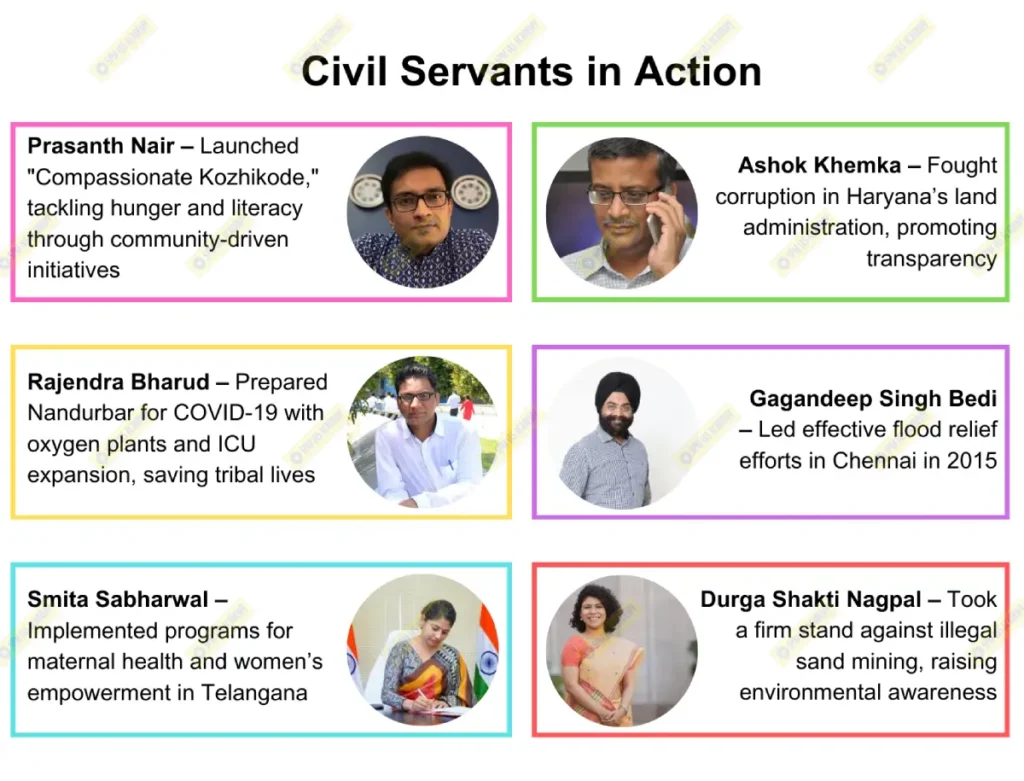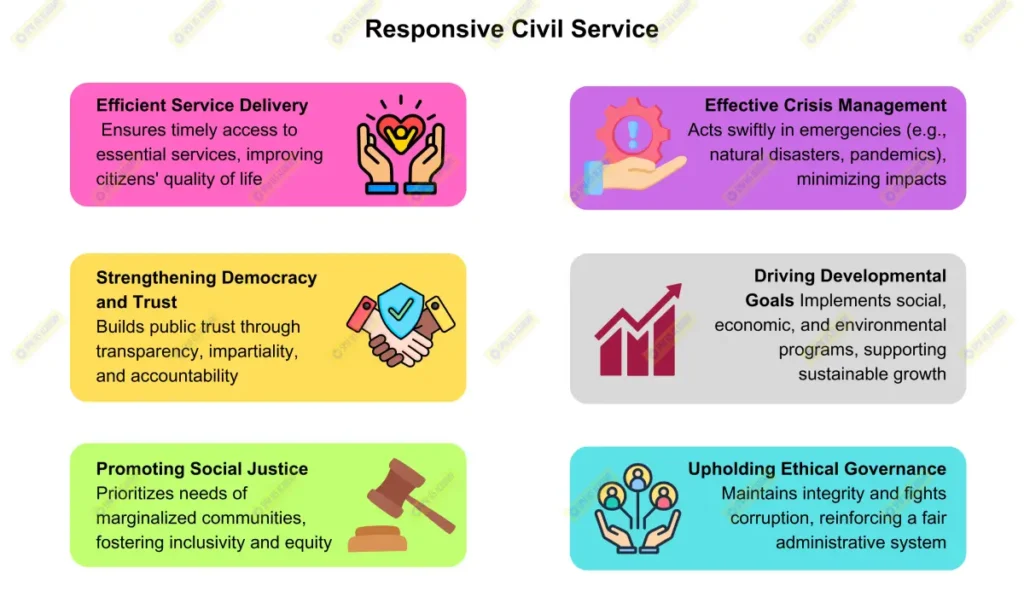To enhance the efficiency and responsiveness of the Civil Services in India amid changing social, political, and economic contexts, several measures have been proposed and implemented. These reforms are aimed at addressing challenges such as bureaucratic inertia, lack of accountability, and a need for better alignment with public needs.

Key Measures for Improving Efficiency and Responsiveness
Mission Karmayogi – Capacity Building Initiative:
- Launched in 2020, Mission Karmayogi is a national program focused on continuous learning and skill development for civil servants at all levels. It emphasizes a shift from rule-based to role-based governance by equipping civil servants with relevant skills in emerging areas like digital governance, data analytics, and citizen engagement.
- This initiative is built around a digital platform (iGOT) that provides courses for ongoing training, aiming to create a future-ready bureaucracy capable of adapting to evolving governance demands.
Lateral Entry for Specialized Skills:
- To bring in domain expertise and bridge skill gaps within the bureaucracy, the government has initiated lateral entry into civil services for experts from the private sector and academia. This approach, recommended by the Niti Aayog and 2nd Administrative Reforms Commission (ARC), injects fresh perspectives and specialized knowledge into departments dealing with areas like finance, infrastructure, and healthcare.
- The Parliamentary Standing Committee on Personnel, Public Grievances, Law and Justice endorsed lateral entry, terming it a method to “infuse innovation and efficiency” by supplementing traditional administrative experience with technical and sector-specific expertise.

Performance-Based Appraisal Systems:
- To address bureaucratic complacency and ensure accountability, the Government of India has introduced performance-based appraisal systems. The Annual Performance Appraisal Report (APAR) now incorporates outcome-based indicators, focusing on impact rather than mere process completion.
- The Sevottam Model, recommended by the 2nd ARC, establishes a framework for citizen-centric governance, including performance assessment based on feedback from citizens, aligning civil servants’ performance with public satisfaction and service delivery.
Adoption of E-Governance and Digital Tools:
- E-governance initiatives like Digital India and the Centralized Public Grievance Redress and Monitoring System (CPGRAMS) streamline processes, increase transparency, and improve public access to services. Digital tools reduce red tape, ensure faster processing, and enable citizens to track their grievances online.
- The Public Service Delivery Act, adopted by several states, mandates timely delivery of services. This ensures that services like issuing licenses, certificates, and pensions are completed within set timeframes, promoting responsiveness in day-to-day administration.
Strengthening Ethical Foundations:
- To reinforce integrity within the civil services, the Ethics in Governance report by the 2nd ARC recommended a Code of Ethics, alongside transparency and accountability mechanisms to prevent corruption. Training programs under Mission Karmayogi also emphasize ethical conduct, aiming to build a citizen-first approach.
- Furthermore, the Prevention of Corruption (Amendment) Act, 2018 strengthened anti-corruption measures, reducing delays in action against officials found guilty of misconduct, thereby enhancing public trust in the civil services.
Decentralization and Empowering Local Bodies:
- Decentralization reforms enable greater public participation in decision-making processes. The 73rd and 74th Constitutional Amendments have empowered Panchayati Raj Institutions (PRIs) and urban local bodies, allowing civil servants to work closely with local representatives to address specific community needs.
- The Punchhi Commission on Centre-State Relations suggested further decentralization for more direct and responsive governance, especially crucial in a rapidly evolving socio-economic landscape.
Making the Indian Civil Service more efficient and responsive requires a multifaceted approach involving continuous capacity building, performance-based appraisals, e-governance, and ethical reforms. By integrating recent initiatives like Mission Karmayogi, lateral entry, and digital governance, the civil services are increasingly equipped to address the dynamic needs of a changing India.
As Sardar Patel, regarded as the “Father of the Indian Civil Services,” emphasized, civil servants must remain “the steel frame” of India’s administration, but with adaptability and sensitivity to the people’s needs.











